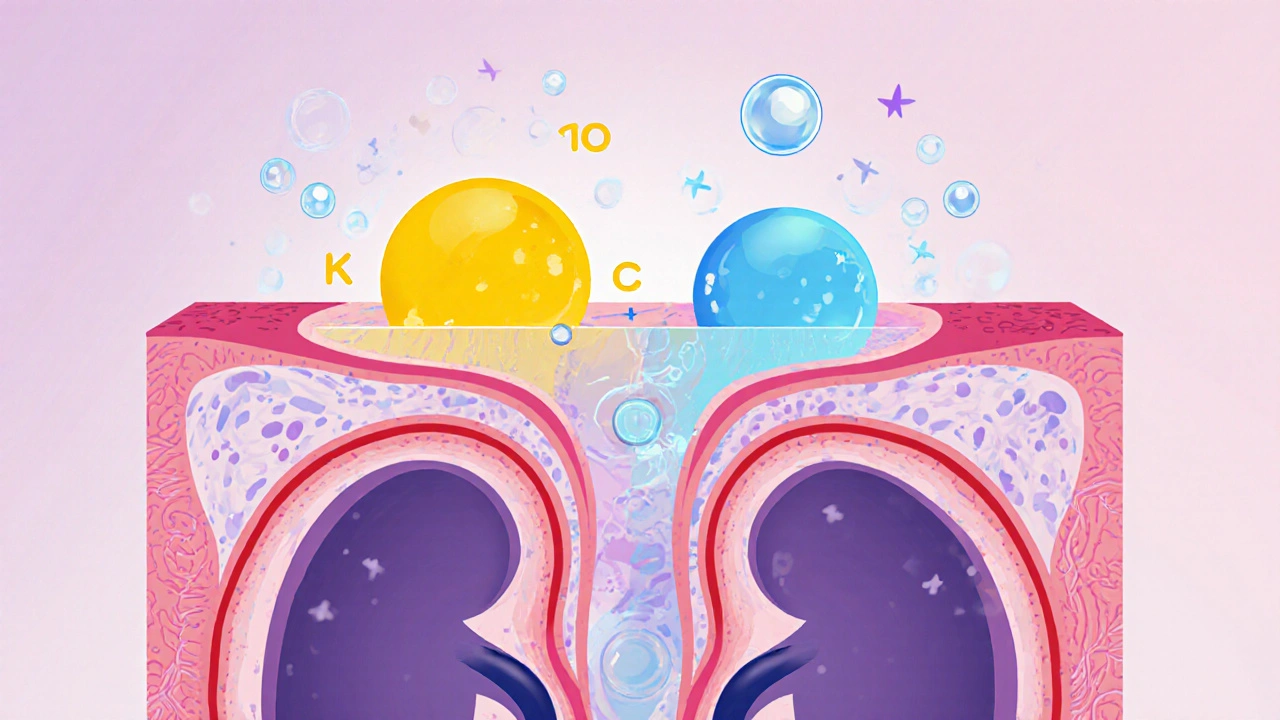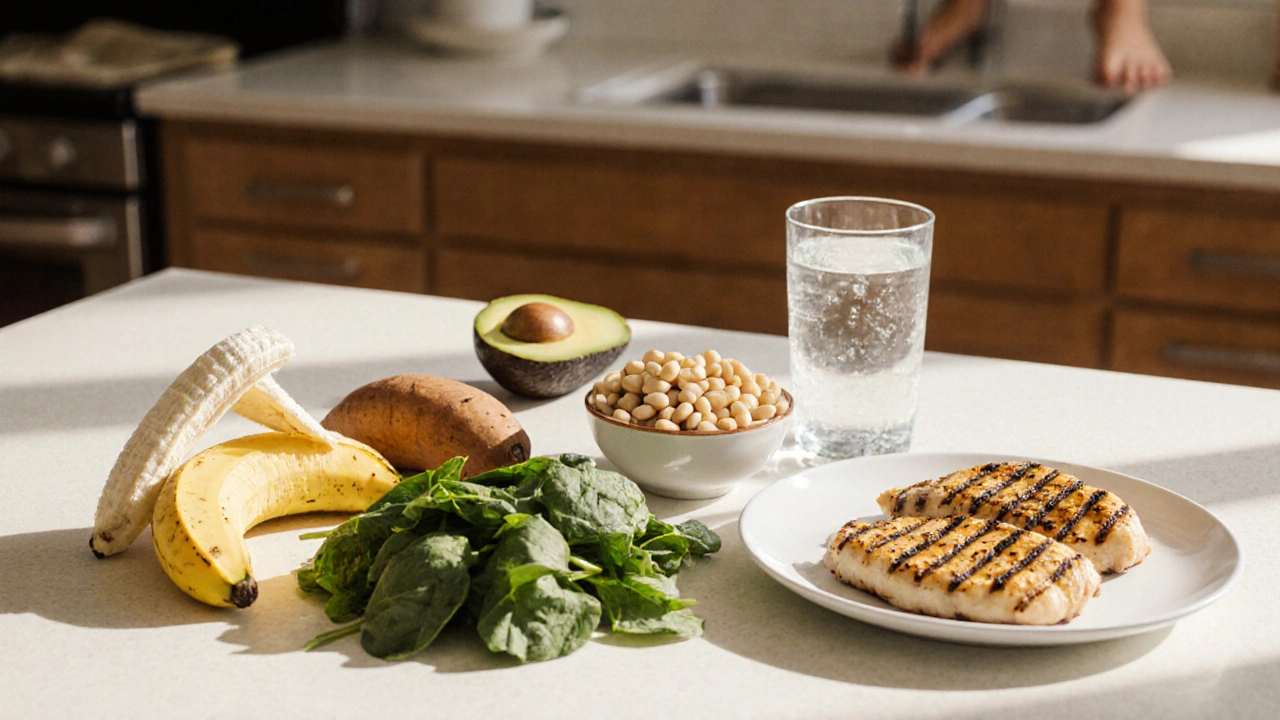Potassium Intake Calculator
Calculate Your Potassium Intake
Estimate how much potassium you're getting from your daily meals
Your Potassium Intake
Total potassium intake: 0 mg
Recommended range: 2,600-3,400 mg
Your Potassium Balance
Your potassium intake is within the recommended range.
Quick Takeaways
- Potassium pulls excess water out of cells, easing swelling.
- Balanced intake helps kidneys flush sodium and excess fluid.
- Good food sources include bananas, sweet potatoes, beans, and leafy greens.
- Most adults need about 2,600-3,400mg per day; too much can be risky.
- Combine potassium‑rich foods with low‑sodium meals for best results.
Ever wonder why your legs feel puffy after a long flight? That’s fluid retention, or edema, and diet plays a bigger part than you might think. Below we’ll break down how potassium works behind the scenes to keep that extra water in check.
Potassium is an essential electrolyte that helps regulate fluid balance, nerve signals, and muscle contractions. When you eat enough of it, your body becomes better at moving water out of the spaces between cells and into the bloodstream, where the kidneys can get rid of it.
Sodium is another key electrolyte that holds onto water and raises blood pressure when consumed in excess. Think of sodium as the “hold‑on‑to‑water” partner and potassium as the “let‑go‑of‑water” partner. A healthy ratio between the two keeps swelling at bay.
Kidneys are the body’s filtration system that balances electrolytes and eliminates excess fluid through urine. They rely on the push‑pull dynamic of potassium and sodium to decide how much water to discard.
Fluid Retention (or edema) is the accumulation of excess fluid in the body's tissues, often noticeable in the legs, ankles, and hands. It can stem from a salty diet, inactivity, hormonal changes, or certain medications.
Blood Pressure is the force of blood against artery walls; high levels often accompany high sodium and low potassium intake. Lowering blood pressure with potassium also reduces the strain that leads to swelling.
Electrolytes are minerals with an electric charge that help transmit signals and maintain fluid equilibrium in the body. Potassium, sodium, calcium, and magnesium all belong to this family.
Bananas are a popular fruit delivering about 400mg of potassium per medium piece. They’re a quick, tasty way to boost your potassium intake.
Hypertension is chronically high blood pressure, a condition linked to excess sodium and insufficient potassium. Managing potassium can be a natural adjunct to medication.
How Potassium Moves Water Out of Your Tissues
The science is surprisingly simple. Inside each cell, potassium sits at a higher concentration than in the blood. Sodium does the opposite, hanging out more in the bloodstream. This creates an osmotic gradient: water wants to move where the solute concentration is lower.
When you increase potassium through food, cells pull a tiny bit more potassium inside, and water follows the gradient out of the interstitial (between‑cell) space. The kidneys then sense the shift, filter more sodium, and excrete the extra fluid as urine.
In practice, you’ll notice less puffiness in the morning, lighter shoes, and reduced ankle swelling after a few weeks of a potassium‑rich diet.

Top Natural Sources of Potassium
Whole foods beat supplements for most people because they also supply fiber, vitamins, and other minerals that support kidney function.
- Bananas - 400mg per medium fruit; easy snack or smoothie base.
- Sweet potatoes - 540mg per cup, baked; great as a side or mash.
- White beans - 600mg per half‑cup; toss into soups or salads.
- Spinach - 540mg per cooked cup; use in omelets or stir‑fries.
- Avocado - 485mg per fruit; spreads well on toast.
Mixing these foods throughout the day keeps a steady potassium supply and helps you avoid the spike‑and‑crash feeling that can come from highly processed salty snacks.
How Much Potassium Do You Really Need?
The Dietary Guidelines for Americans (2020‑2025) recommend 2,600mg per day for women and 3,400mg for men. If you’re active, pregnant, or breastfeeding, you might need a bit more.
Here’s a quick way to gauge your intake:
- One medium banana = ~400mg
- One cup cooked spinach = ~540mg
- One cup baked sweet potato = ~540mg
Three to four servings of these foods each day typically hit the target without going overboard.
When Too Little or Too Much Becomes a Problem
Low potassium (hypokalemia) can cause muscle cramps, fatigue, and even irregular heartbeats. It often shows up in people who take diuretics or have chronic diarrhea.
High potassium (hyperkalemia) is rarer but dangerous for those with kidney disease, because their kidneys can’t clear the excess. Symptoms include tingling, nausea, and a rapid pulse.
Bottom line: aim for the recommended range and talk to a healthcare professional if you have kidney issues or are on medication that affects electrolytes.

Practical Tips to Boost Potassium and Cut Sodium
- Swap salty chips for roasted chickpeas seasoned with herbs.
- Season meals with lemon juice, garlic, or vinegar instead of table salt.
- Choose fresh or frozen vegetables over canned versions that often contain added sodium.
- Read labels: look for “no added salt” or “low‑sodium” tags.
- Drink plenty of water; adequate hydration helps kidneys flush excess sodium.
These small swaps add up, especially when paired with a potassium‑rich plate.
Potassium vs. Sodium: Quick Comparison
| Feature | Potassium | Sodium |
|---|---|---|
| Typical Daily Intake (US) | 2,600-3,400mg | ≈3,400mg (often higher) |
| Primary Effect on Fluid | Encourages fluid excretion | Promotes fluid retention |
| Impact on Blood Pressure | Helps lower | Can raise |
| Key Food Sources | Bananas, sweet potatoes, beans, leafy greens | Processed foods, canned soups, snack salts |
| Risk of Excess | Hyperkalemia (kidney issues) | Hypertension, edema |
Frequently Asked Questions
Can I take potassium supplements instead of eating food?
Supplements can be useful if a doctor orders them, but most people get enough from a balanced diet. Food also gives fiber and vitamins that help the kidneys work better.
How quickly can I see a reduction in swelling?
Changes are usually noticeable within 1-2 weeks if you consistently eat potassium‑rich foods and cut back on salty snacks. Severe edema may need medical treatment.
Is there a safe upper limit for potassium?
For healthy adults, the upper limit is about 4,700mg per day. If you have kidney disease, any amount above the recommended range could be risky, so check with your doctor.
Does cooking destroy potassium?
Cooking can leach some potassium into water, especially boiling. Steaming, roasting, or eating raw veggies preserves more of the mineral.
Can a high‑potassium diet lower my blood pressure?
Multiple studies show that adding 1,500-2,000mg of potassium daily can reduce systolic pressure by 3-5mmHg, especially when sodium intake stays low.


Patrick McVicker
October 14, 2025
Just tossing a quick tip your way – chuck a handful of spinach into your morning smoothie, it’s an easy potassium boost and you won’t even notice the taste. :)
Liliana Phera
October 21, 2025
Look, the article glosses over how brutal low potassium can be for anyone on diuretics; you’re practically begging for muscle cramps and fatigue if you ignore this. Stop tiptoeing around the facts and start loading up on beans and sweet potatoes now.
Dean Briggs
October 27, 2025
When we contemplate the delicate balance of electrolytes, it becomes evident that potassium is not merely a dietary footnote but a central protagonist in the narrative of fluid homeostasis. The osmotic gradient it creates functions like a silent referee, directing water away from interstitial spaces and toward the bloodstream where the kidneys can perform their cleansing duties. This interplay, however, is a symphony that requires consistent participation from our daily nutrition, not occasional indulgence in a banana or an avocado. Consider the cumulative effect of each potassium-rich serving: a cup of cooked spinach, a medium banana, a baked sweet potato – each contributes a substantial fraction toward the recommended daily intake. Moreover, the timing of intake matters; spreading consumption across meals maintains a steady plasma potassium concentration, avoiding the pitfalls of spikes and subsequent rapid excretion. The kidneys, in turn, modulate sodium reabsorption in response to this potassium influx, thereby attenuating the hypertensive effects associated with high sodium diets. It is also critical to recognize that excessive sodium diminishes the efficacy of potassium, essentially neutralizing its fluid‑moving capabilities. Consequently, a dual approach of reducing sodium and augmenting potassium yields synergistic benefits, often reflected in decreased peripheral edema within a few weeks. For individuals engaged in high‑intensity training, this balance supports muscle function and mitigates cramping, which are frequent consequences of electrolyte imbalance. Additionally, clinical studies have correlated higher potassium intake with lower systolic blood pressure, underscoring its role in cardiovascular health. If you suffer from chronic kidney disease, the equation changes dramatically; the kidneys’ diminished clearance capacity necessitates stricter monitoring of potassium to prevent hyperkalemia, a potentially life‑threatening condition. Therefore, personalization of intake, guided by medical advice, becomes paramount. In the broader context, public health initiatives that promote potassium‑rich foods while discouraging processed, sodium‑laden snacks could substantially reduce the prevalence of hypertension and its downstream complications. To summarize, potassium is the unsung hero that draws excess fluid out of tissues, supports renal sodium excretion, and contributes to overall vascular health – a cascade of benefits that starts on your plate. Embrace a varied diet rich in leafy greens, legumes, and tubers, and you’ll likely notice less puffiness, lighter shoes, and a more stable blood pressure without the need for aggressive pharmacological interventions.
Sadie Speid
November 3, 2025
Great rundown! Just add that swapping out a salty snack for roasted chickpeas can give you a potassium punch while keeping the crunch you love.
Sue Ross
November 10, 2025
I appreciate the practical angle; many of us juggling work and family need clear steps. Incorporating a banana into breakfast and a handful of beans at dinner feels doable.
Rohinii Pradhan
November 16, 2025
From a nutritional science perspective, the article correctly identifies the osmotic mechanisms, yet it fails to cite primary literature that substantiates the 2,600‑3,400 mg recommendation. Peer‑reviewed sources would enhance credibility.
Anna-Lisa Hagley
November 23, 2025
Interesting points, though I’d caution against thinking potassium alone solves edema; underlying medical issues must be ruled out.
A Walton Smith
November 30, 2025
Potassium matters.
Theunis Oliphant
December 6, 2025
Honestly, the glorification of bananas is a bit trite; a truly sophisticated palate should seek out lesser‑known sources like dried apricots or beet greens for that potassium surge.
India Digerida Para Occidente
December 13, 2025
While I respect the sentiment, let’s be clear: relying solely on fruit for potassium neglects the power of legumes, which deliver superior bioavailability and fiber.